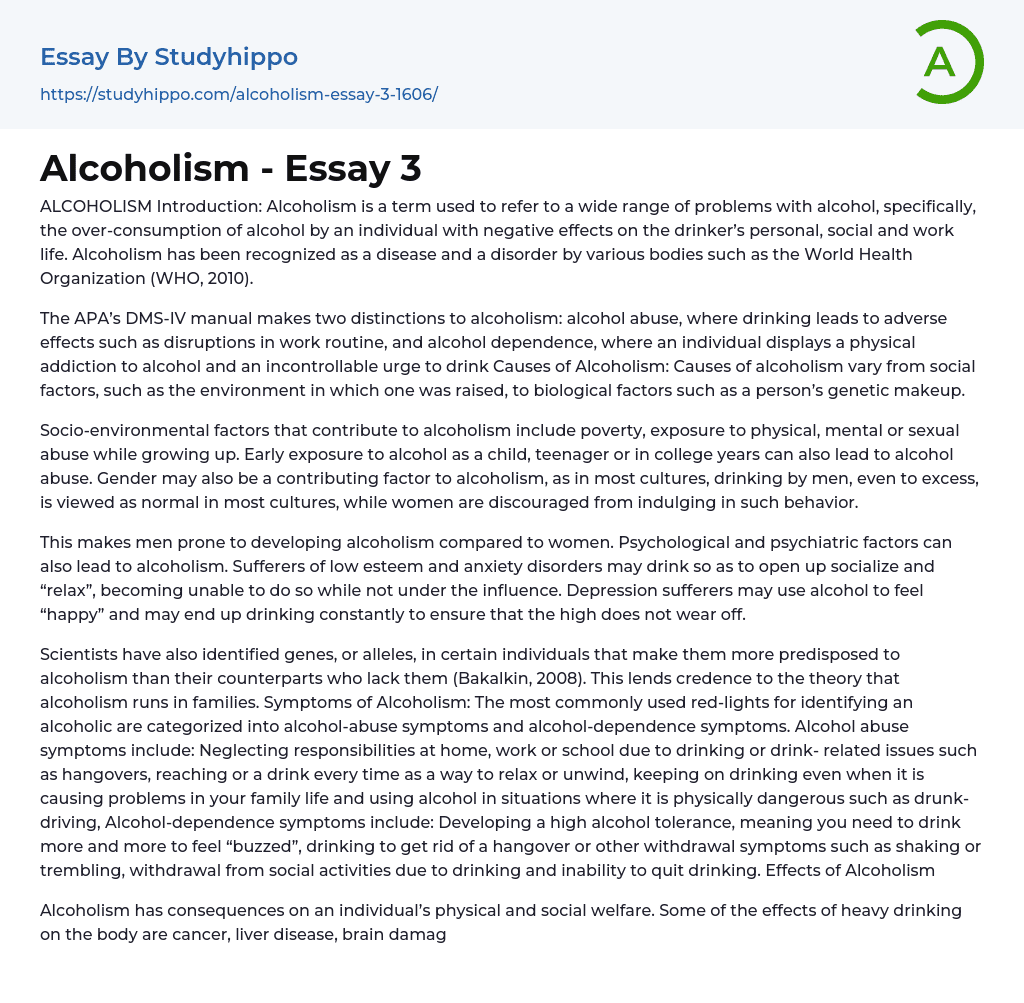ALCOHOLISM Introduction: Alcoholism is a term used to refer to a wide range of problems with alcohol, specifically, the over-consumption of alcohol by an individual with negative effects on the drinker’s personal, social and work life. Alcoholism has been recognized as a disease and a disorder by various bodies such as the World Health Organization (WHO, 2010).
The APA’s DMS-IV manual makes two distinctions to alcoholism: alcohol abuse, where drinking leads to adverse effects such as disruptions in work routine, and alcohol dependence, where an individual displays a physical addiction to alcohol and an incontrollable urge to drink Causes of Alcoholism: Causes of alcoholism vary from social factors, such as the environment in which one was raised, to biological factors such as a person’s genetic makeup.
Socio-environmental factors that contribute to alcoholism include p
...overty, exposure to physical, mental or sexual abuse while growing up. Early exposure to alcohol as a child, teenager or in college years can also lead to alcohol abuse. Gender may also be a contributing factor to alcoholism, as in most cultures, drinking by men, even to excess, is viewed as normal in most cultures, while women are discouraged from indulging in such behavior.
This makes men prone to developing alcoholism compared to women. Psychological and psychiatric factors can also lead to alcoholism. Sufferers of low esteem and anxiety disorders may drink so as to open up socialize and “relax”, becoming unable to do so while not under the influence. Depression sufferers may use alcohol to feel “happy” and may end up drinking constantly to ensure that the high does not wear off.
Scientists have also identified genes, or alleles, in certain individuals that make them
more predisposed to alcoholism than their counterparts who lack them (Bakalkin, 2008). This lends credence to the theory that alcoholism runs in families. Symptoms of Alcoholism: The most commonly used red-lights for identifying an alcoholic are categorized into alcohol-abuse symptoms and alcohol-dependence symptoms. Alcohol abuse symptoms include: Neglecting responsibilities at home, work or school due to drinking or drink- related issues such as hangovers, reaching or a drink every time as a way to relax or unwind, keeping on drinking even when it is causing problems in your family life and using alcohol in situations where it is physically dangerous such as drunk- driving, Alcohol-dependence symptoms include: Developing a high alcohol tolerance, meaning you need to drink more and more to feel “buzzed”, drinking to get rid of a hangover or other withdrawal symptoms such as shaking or trembling, withdrawal from social activities due to drinking and inability to quit drinking. Effects of Alcoholism
Alcoholism has consequences on an individual’s physical and social welfare. Some of the effects of heavy drinking on the body are cancer, liver disease, brain damage and heart problems. Socially, the alcoholic faces work problems, unemployment, poverty, divorce and ostracism from their family and friends (Smart, 2007). References Bakalkin, G. (2008). Alcoholism-associated molecular adaptations in brain neurocognitive circuits. Eurekalert. org. Retrieved 26-1-2012 Smart, L. (2007). Alcohol and Human Health. Oxford, UK: Oxford University Press WHO. (2010). Alcohol. World Health Organization.
- Cloning essays
- Medical Ethics essays
- Patient essays
- Therapy essays
- drugs essays
- Cannabis essays
- Aspirin essays
- Cardiology essays
- Hemoglobin essays
- Pharmacology essays
- Surgery essays
- alternative medicine essays
- Plastic Surgery essays
- Organ Donation essays
- Vaccines essays
- Medical essays
- Dentist essays
- Psychological Trauma essays
- Physical therapy essays
- Cold essays
- Cocaine essays
- Why Marijuana Should Be Legalized essays
- Drug Abuse essays
- Teenage Drug Abuse essays
- Heart Disease essays
- Artery essays
- Learning Disability essays
- Bipolar Disorder essays
- Dyslexia essays
- Major Depressive Disorder essays
- Mental Disorder essays
- Adhd essays
- Anxiety essays
- Depression essays
- Psychosis essays
- Schizophrenia essays
- Antisocial Personality Disorder essays
- Stress essays
- Suicide essays
- Mental Illness essays
- Depression And Anxiety essays
- Insanity essays
- Tension essays
- Suicide Prevention essays
- alcoholism essays
- Casino essays
- Cell Phone Addiction essays
- Heroin essays
- Smoking essays
- Social Media Addiction essays




